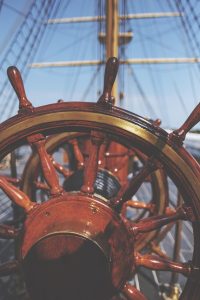It is really curious that the sailing trips that we take at Alegría Marineros are inspired by thousands of years ago. No matter how modern you can see our boats, the truth is that this type of navigation was already carried out thousands of years ago.
Precisely because of all the history it has and how these boats have evolved over the years, in this article we are going to deal a little with the history of sailing.
Knowing the origins of this type of navigation will allow you to enjoy our trips much more and, of course, also to be able to get an idea of what conditions or how people travelled thousands of years ago.
Who Invented Sailing
The first thing to make clear is that sailing was not invented by a single person or, at least, there is no record of it. It is the gradual development perpetrated over thousands of years by different cultures spread all over the world.
The first means of transport to travel long distances on the water, whether rivers, lakes or seas, were sailing boats. While these vessels originally only had commercial use, over time they ended up having military use.
The first evidence of sailing can be found in the first great civilizations. Boats with sails have been found in Egyptian tombs dating back to 3200 B.C., while there is also evidence that the Sumerians also used them to navigate the Tigris and Euphrates around 3000 B.C. and that the Chinese developed them around 2500 B.C.
Early Civilizations and Their Use of Sailing Vessels
The Egyptians, Phoenicians, and Babylonians are believed to have been the first civilizations to make use of these sailing vessels. Although there is no evidence that the Egyptians were the first builders of these vessels, they were the first to leave written documents about navigation and ships.
The first element used to build these sailing vessels was papyrus, a material that grew abundantly on the banks of the Nile. Thanks to papyrus, boats were created that were used to cross the river from one bank to the other, even for other activities such as fishing. These rudimentary vessels soon evolved, as when the papyrus was submerged it lost its consistency and the vessel suffered.
There is no doubt that the invention of sailing was the most important event in the history of navigation and, due to the impact and importance it had, work was done on its development over the years.
What were the first voyages of the sailboats like?
The first voyages on sailing ships date back to the shores of the eastern Mediterranean , there was Byblos. The reason for the trips was to look for precious woods with which the palatial rooms of the time were built. Trips to Cyprus to obtain copper and silver were also frequent, and also to the Aegean Sea, where they sought to bring manufactured objects.
The Egyptians took their voyages to the shores of the Indian Ocean in search of ebony, ivory, incense, and spices, among other goods. These sailing trips were some of the ones that led to the creation of the first maps of the area.
Sailboats as we know them today
These forerunner vessels of sailboats are quite far from what a sailboat looks like today. We have to go all the way back to the 17th century in northern Europe to find something more like what we know today. We’re talking about ships that were used for hunting, but were big enough to live on and were propelled by sail.
As in the past, the use of this boat continued to evolve over the years, in this case, to a less hostile activity such as leisure. This is due to the fact that Charles II of England was aware of the activity of these house-boats in northern Europe and adapted them with the term yacht.
These yachts would soon become the favorite pastime of the English nobility until the first yacht club known as the Cork Water Club was created in Ireland in 1720.
Some of the Great Sailing Voyages of Antiquity
Nowadays sailboats make great trips, for example, it is common to carry out expeditions to Antarctica. Although this may seem somewhat modern, the truth is that in history there have already been several milestones with these sailing vessels, perhaps much more memorable, if we take into account the days they were and how little evolved they were.
In the 15th century BC, Queen Hatsepsut sent a fleet of five galleys sailing across the Red Sea to the Frankincense Lands. This expedition was a success and the boats returned full of incense, gold and ebony trees.
A little more recently, in 550 B.C., the Greek navigator Euthymenes of Massilia sailed down the coast of West Africa to reach the Senegal River. By order of the king of Persia Darius I, in 500 B.C. the Greek navigator Scyllas of Carianda undertook the descent of the Indus to the Indian Ocean to sail to the West, circling Arabia and reaching Egypt through the Red Sea.
Sailing is still very important today and has basically been for thousands of years. In this way, the next time you get on a sailboat, remember all these old sailors who, with much more rudimentary equipment and tools, were able to travel a large number of kilometers on the water.










